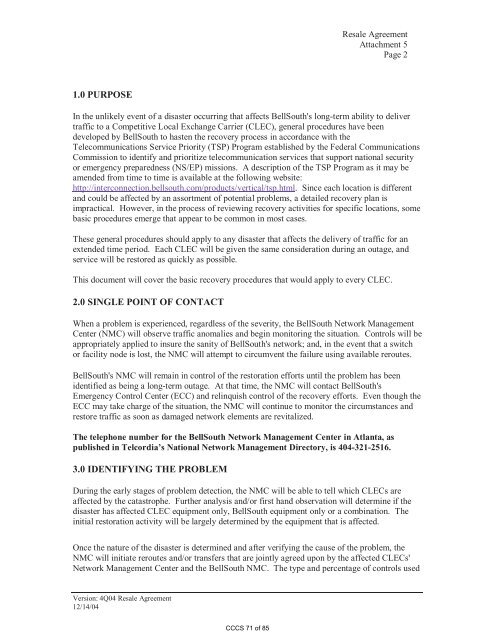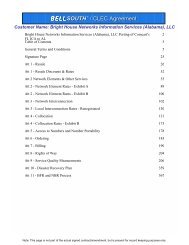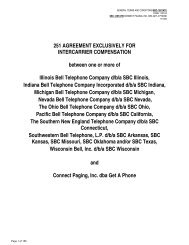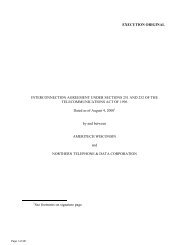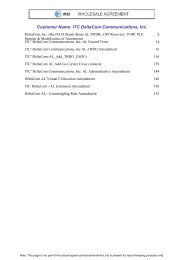Access One Communications, Inc.
Access One Communications, Inc.
Access One Communications, Inc.
You also want an ePaper? Increase the reach of your titles
YUMPU automatically turns print PDFs into web optimized ePapers that Google loves.
1.0 PURPOSE<br />
Version: 4Q04 Resale Agreement<br />
12/14/04<br />
Resale Agreement<br />
Attachment 5<br />
Page 2<br />
In the unlikely event of a disaster occurring that affects BellSouth's long-term ability to deliver<br />
traffic to a Competitive Local Exchange Carrier (CLEC), general procedures have been<br />
developed by BellSouth to hasten the recovery process in accordance with the<br />
Telecommunications Service Priority (TSP) Program established by the Federal <strong>Communications</strong><br />
Commission to identify and prioritize telecommunication services that support national security<br />
or emergency preparedness (NS/EP) missions. A description of the TSP Program as it may be<br />
amended from time to time is available at the following website:<br />
http://interconnection.bellsouth.com/products/vertical/tsp.html. Since each location is different<br />
and could be affected by an assortment of potential problems, a detailed recovery plan is<br />
impractical. However, in the process of reviewing recovery activities for specific locations, some<br />
basic procedures emerge that appear to be common in most cases.<br />
These general procedures should apply to any disaster that affects the delivery of traffic for an<br />
extended time period. Each CLEC will be given the same consideration during an outage, and<br />
service will be restored as quickly as possible.<br />
This document will cover the basic recovery procedures that would apply to every CLEC.<br />
2.0 SINGLE POINT OF CONTACT<br />
When a problem is experienced, regardless of the severity, the BellSouth Network Management<br />
Center (NMC) will observe traffic anomalies and begin monitoring the situation. Controls will be<br />
appropriately applied to insure the sanity of BellSouth's network; and, in the event that a switch<br />
or facility node is lost, the NMC will attempt to circumvent the failure using available reroutes.<br />
BellSouth's NMC will remain in control of the restoration efforts until the problem has been<br />
identified as being a long-term outage. At that time, the NMC will contact BellSouth's<br />
Emergency Control Center (ECC) and relinquish control of the recovery efforts. Even though the<br />
ECC may take charge of the situation, the NMC will continue to monitor the circumstances and<br />
restore traffic as soon as damaged network elements are revitalized.<br />
The telephone number for the BellSouth Network Management Center in Atlanta, as<br />
published in Telcordia’s National Network Management Directory, is 404-321-2516.<br />
3.0 IDENTIFYING THE PROBLEM<br />
During the early stages of problem detection, the NMC will be able to tell which CLECs are<br />
affected by the catastrophe. Further analysis and/or first hand observation will determine if the<br />
disaster has affected CLEC equipment only, BellSouth equipment only or a combination. The<br />
initial restoration activity will be largely determined by the equipment that is affected.<br />
Once the nature of the disaster is determined and after verifying the cause of the problem, the<br />
NMC will initiate reroutes and/or transfers that are jointly agreed upon by the affected CLECs'<br />
Network Management Center and the BellSouth NMC. The type and percentage of controls used<br />
CCCS 71 of 85


